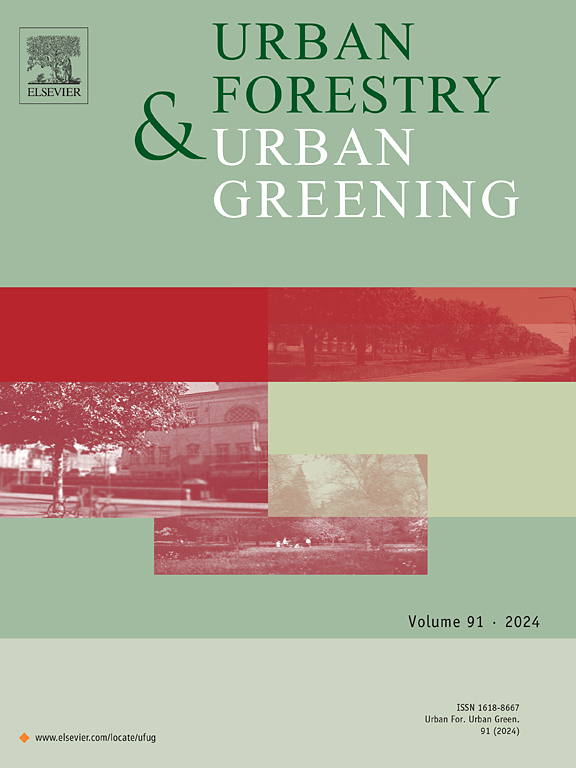Mapping wild nature areas to identify priority areas for urban rewilding in cities: A process-oriented approach
IF 6
2区 环境科学与生态学
Q1 ENVIRONMENTAL STUDIES
引用次数: 0
Abstract
Urban rewilding initiatives are gaining traction in cities, yet little remains known about the spatial opportunities for transitioning greenspaces into rewilding sites. This paper advances a process-oriented framing of urban wild nature areas (WNAs) and proposes a novel methodological approach for mapping existing WNAs at the city-scale, thereby shedding light on the potentials for urban rewilding across greenspace types and urban environments. Using Vienna as a case study, we identify WNAs as greenspaces predominantly shaped by natural succession processes and devoid of vegetation management. NDVI timeseries derived from Sentinel-2-satellite data for the period 2017–2022 are processed using a Random Forest algorithm to distinguish between unmanaged and managed vegetation annually and integrated into a multi-year composite map of ‘urban vegetation management intensity’. Based on this map and a set of objective cut-off values, 1298 WNAs are identified, representing 29.5 % of the city’s total urban greenspace and 14.9 % of the city’s total area. WNAs are distributed across diverse urban settings and greenspace types, with the majority being found in formal greenspaces such as forests, meadows and parks, and low-density built-up areas. The key strength of the process-oriented approach lies in its ability to detect WNAs dominated by natural succession, regardless of historic origin, greenspace type, and governance structure, thereby providing a baseline against which the full potential for urban rewilding can be evaluated. We demonstrate the methods’ utility in identifying potentials for urban rewilding, emphasising the importance of directing rewilding efforts towards residential greenspaces, urban parks, and street greenery, especially in densely built inner-city districts.
绘制野生自然区域图,确定城市野化的优先区域:以过程为导向的方法
城市野化倡议在城市中的影响力越来越大,但人们对将绿地转变为野化场所的空间机会仍然知之甚少。本文提出了以过程为导向的城市野生自然区(WNAs)框架,并提出了一种新颖的方法论,用于绘制城市尺度上现有的野生自然区,从而揭示不同绿地类型和城市环境的城市野化潜力。以维也纳为例,我们将 WNAs 识别为主要由自然演替过程形成且缺乏植被管理的绿地。我们使用随机森林算法处理了从 "哨兵-2 "卫星数据中获取的 2017-2022 年 NDVI 时间序列,以区分每年的无管理植被和有管理植被,并将其整合到 "城市植被管理强度 "的多年综合地图中。根据该地图和一组目标截断值,确定了 1298 个 WNA,占全市城市绿地总面积的 29.5%,占全市总面积的 14.9%。WNAs 分布在不同的城市环境和绿地类型中,大部分位于正规绿地(如森林、草地和公园)和低密度建筑区。这种以过程为导向的方法的主要优势在于,无论历史渊源、绿地类型和治理结构如何,它都能检测出以自然演替为主的世界自然遗产地,从而为评估城市野化的全部潜力提供了一个基线。我们展示了该方法在确定城市野化潜力方面的实用性,强调了将野化工作引向居住区绿地、城市公园和街道绿化的重要性,尤其是在建筑密集的内城区。
本文章由计算机程序翻译,如有差异,请以英文原文为准。
求助全文
约1分钟内获得全文
求助全文
来源期刊

Urban Forestry & Urban Greening
FORESTRY-
CiteScore
11.70
自引率
12.50%
发文量
289
审稿时长
70 days
期刊介绍:
Urban Forestry and Urban Greening is a refereed, international journal aimed at presenting high-quality research with urban and peri-urban woody and non-woody vegetation and its use, planning, design, establishment and management as its main topics. Urban Forestry and Urban Greening concentrates on all tree-dominated (as joint together in the urban forest) as well as other green resources in and around urban areas, such as woodlands, public and private urban parks and gardens, urban nature areas, street tree and square plantations, botanical gardens and cemeteries.
The journal welcomes basic and applied research papers, as well as review papers and short communications. Contributions should focus on one or more of the following aspects:
-Form and functions of urban forests and other vegetation, including aspects of urban ecology.
-Policy-making, planning and design related to urban forests and other vegetation.
-Selection and establishment of tree resources and other vegetation for urban environments.
-Management of urban forests and other vegetation.
Original contributions of a high academic standard are invited from a wide range of disciplines and fields, including forestry, biology, horticulture, arboriculture, landscape ecology, pathology, soil science, hydrology, landscape architecture, landscape planning, urban planning and design, economics, sociology, environmental psychology, public health, and education.
 求助内容:
求助内容: 应助结果提醒方式:
应助结果提醒方式:


